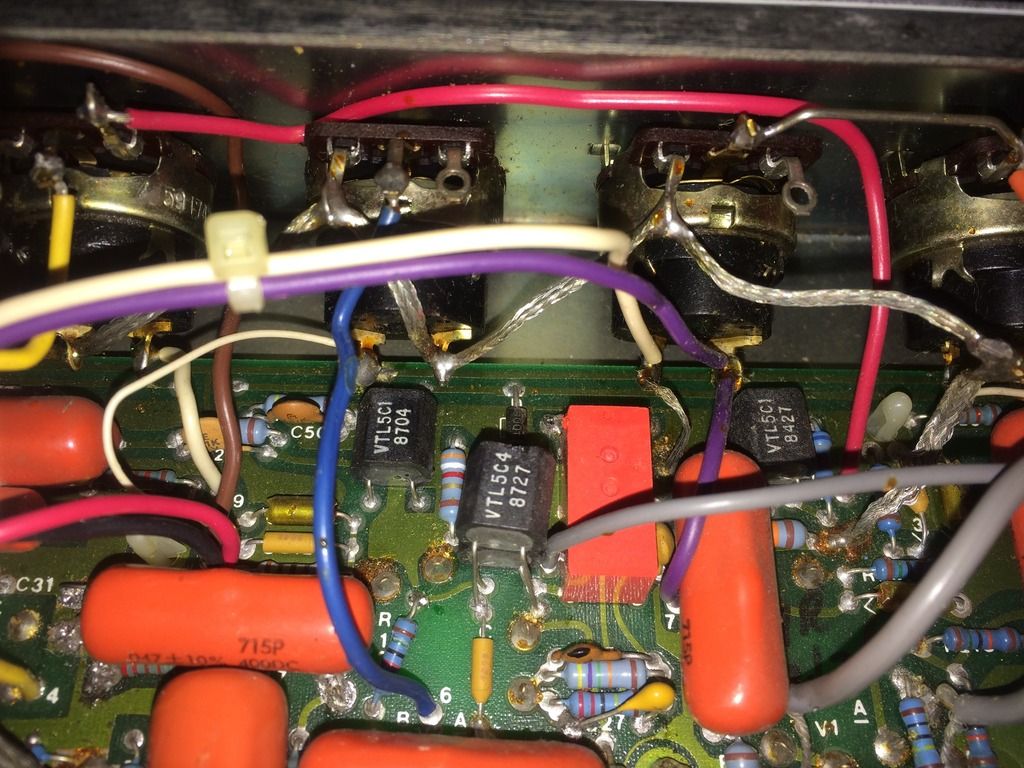This is a good way to check and make sure where the problem is at first off. I took this right out of the Matk III manual. It helps figure out which tube (the most likely culprit to your issue) is the one you need to look at.
Also its very easy to not get the pins exactly in the sockets correctly unless you take the chassis out of the cab.
---------------------------
PREAMP TUBES
Your Boogie comes with a spare 12AX7 preamp tube set in a little holder so it will always be with your amp. A vast majority of problems can be cured on the spot by simply using this replacement tube! Here are some guidelines: We label the tube locations by the abbreviations V1, V2, V3, V4, and V5. All of these are the small 12AX7 type preamp tubes (the 12AX7
is also known as 7025 or ECC83).
The V1 socket is the one located closest to the Input jack or, as seen from the rear, it is the socket furthest to the right in the front row. The V1 tube is the only one covered by a silver metal shield can. (Shields are not needed for the other tubes and may
actually make them more susceptible to noise.)
If you suspect there is a problem with your amplifier, put it up on a chair or table; don't try to change preamp tubes with it sitting on the floor. Most problems of noise, poor tone, crackling or sputtering, loss of gain, excess feedback and squealing are caused by a poor V1
tube. (This is the first tube in the chain so it is by far the most sensitive.) Remove the shield by pushing it up slightly and rotating.
The tube beneath comes out by gently rocking while pulling downward. Note the position of the "blank space" on the bottom of the tube you just removed. This is the gap between pins. To replace a tube, this gap must line up with the socket. The shield base on the V1 socket has a locating slot (or tab) which indicates the position of the blank space. Once you have the tube in approximately the right position, you "fish around" gently until you feel the pins drop into the socket. Then push it in firmly.
If you accidentally bend a tube pin no problem. Just carefully straighten it out with a small pair of pliers, and try again.
Even people "who are absolutely terrible at fixing things" can successfully change a bad tube if they will just be patient and give it a try. Certainly changing a tube yourself is much less work than taking your amplifier to a service technician who will charge $5 to $20 for the two-to-five minutes of effort. Please note also that the terms of our warranty expect you to provide this simple maintenance. We will supply the replacement tube(s) but we cannot reasonably be expected to pay a technician if you're too lazy to spend the 5 minutes yourself.
Now let's look at the other sockets so you can make an educated guess at which one to change first: V1, as we said, is usually the culprit for general noise problem , especially when both Rhythm and Lead Modes are affected, or if the amp is dead. V2 can also be the culprit for dead amps. If you plug your guitar into the Effects Return Jack and it produces sound - which it should - then chances are your power tubes and output driver (V5) are OK and V1 or V2 is at fault. V3 contains the Lead Mode circuitry so if the problem seems limited to the Lead, Change V3. (High settings of the Lead knobs also require a good quality V1.) V4 is the Reverb tube. Change it if you have a reverb problem. But first check that the reverb cables are plugged in securely. Grey cable goes in the socket toward the front of the amp. V5 is the socket which is set back mid-way to the output tubes. It can be the culprit if the amp is dead, has low gain or lacks boldness, warmth and/or clarity.
If you are in doubt, you should merely replace the preamp tubes one-at-a-time beginning with V1. If the replacement tube fails to cure the problem, put the original tube back into its socket and go on to the next. Don't mix up the tubes and don't bother testing them on a drug-store tester. Only the substitution method works for sure. We advise removing a power tube or two to help gain access to the central preamp tubes.
We strongly recommend you use only genuine MESA tubes. Other tubes - including Groove Tubes
- often aren't good enough





